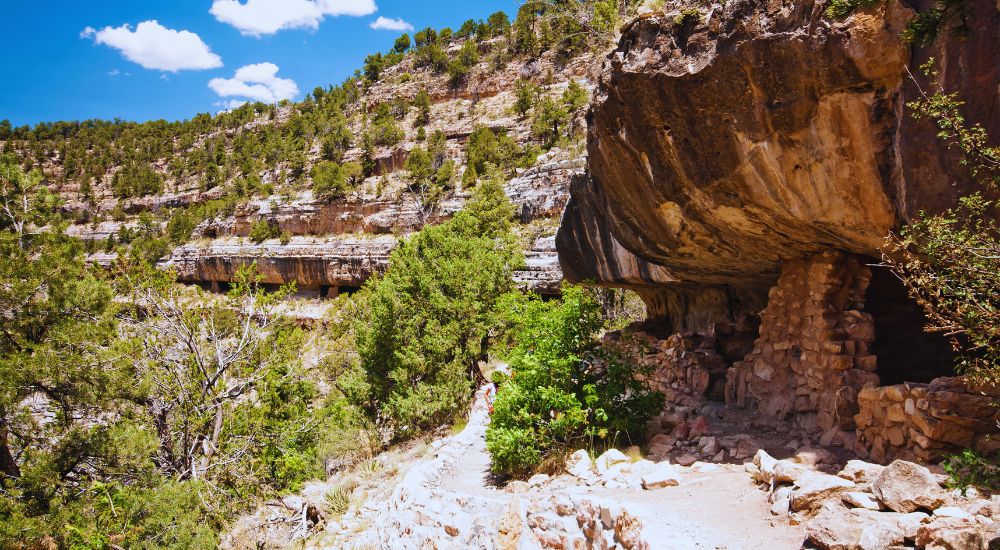Nestled just a few miles southeast of Flagstaff, Walnut Canyon in Arizona is a captivating blend of natural beauty and ancient history. This hidden gem, part of the Walnut Canyon National Monument, offers visitors a chance to step back in time while enjoying stunning canyon landscapes and unique cliff dwellings carved into limestone walls by the ancient Sinagua people.
Whether you’re a hiking enthusiast, a history buff, or simply seeking a scenic escape, Walnut Canyon has something special to offer. With easily accessible trails, educational exhibits, and awe-inspiring views, it’s one of Northern Arizona’s most underrated attractions and a must-visit for anyone exploring the Southwest.
The History of Walnut Canyon

Long before modern visitors set foot here, the Sinagua people an ancestral Puebloan culture inhabited this rugged canyon. Between 600 and 1400 A.D., they constructed remarkable stone dwellings along the cliff walls, using the natural rock overhangs for shelter. The word “Sinagua” itself means “without water” in Spanish, a tribute to their impressive ability to adapt and thrive in the arid high-desert climate.
Today, more than 300 of these cliff dwellings remain scattered throughout the canyon, giving visitors an intimate glimpse into ancient life in the Southwest. These structures are preserved within the boundaries of Walnut Canyon National Monument, which was established in 1915 to protect this irreplaceable archaeological treasure.
Hiking and Outdoor Activities


One of the best ways to experience Walnut Canyon in Arizona is by taking a hike through its well-maintained trails. The two most popular options are the Island Trail and the Rim Trail, each offering unique perspectives of the canyon.
Island Trail
This moderately challenging 1-mile loop descends about 185 feet into the canyon and winds past 25 cliff dwellings. As you walk along narrow paths and stone steps, you’ll feel a powerful connection to the past while surrounded by breathtaking scenery. Be prepared for a bit of a workout on the return climb, especially during summer heat.
Rim Trail
For a more relaxed experience, the Rim Trail provides a gentle stroll along the canyon’s edge. It features scenic overlooks, interpretive signs, and access to a prehistoric pit house and a restored pueblo. The trail is wheelchair accessible in parts, making it perfect for all ages and fitness levels.
For up-to-date maps and hiking tips, visit the official National Park Service page for Walnut Canyon.
Wildlife and Scenic Beauty



The canyon’s ecosystem supports a surprisingly diverse range of wildlife and plant life. From ponderosa pines and junipers to wildflowers and cacti, the landscape transforms dramatically with the seasons. Wildlife enthusiasts may spot mule deer, elk, rock squirrels, and even peregrine falcons soaring above the cliffs.
During spring and summer, the vibrant greens contrast beautifully with the canyon’s reddish-brown rock formations. In winter, a light dusting of snow adds a magical touch to the rugged scenery.
If you’re exploring more natural spots around Flagstaff, don’t miss the guide to Northern Arizona road trips and rentals to help you move between destinations with ease.
Planning Your Visit to Walnut Canyon

Before heading out, it’s important to plan your visit to make the most of your experience. Walnut Canyon National Monument is open daily (except Christmas and New Year’s Day) from 9 AM to 4:30 PM, with the last trail entry allowed at 4 PM. The entrance fee is $25 per vehicle (valid for 7 days), or you can use an America the Beautiful Pass for access.
Facilities include a visitor center with exhibits, a gift shop, and restrooms. Rangers are available to answer questions and provide educational insights into the site’s geology and history.
Location: 3 Walnut Canyon Rd, Flagstaff, AZ 86004
Contact: (928) 526-3367
For more nearby natural and cultural attractions, check out our post on Tombstone town in Arizona, which includes unique architectural sites.
Tips for a Memorable Visit



To ensure a safe and enjoyable trip to Walnut Canyon in Arizona, keep the following tips in mind:
- Bring water: The dry climate can be dehydrating, especially on the Island Trail.
- Wear appropriate shoes: Trails include stone steps and uneven terrain.
- Start early: Especially during summer months to avoid midday heat.
- Respect the ruins: Do not touch or enter the ancient dwellings.
- Check the weather: Snow and storms may cause temporary closures.
For families, this is also an educational opportunity kids can participate in the Junior Ranger Program, available at the visitor center, which adds an interactive element to the visit.
Why Walnut Canyon Deserves a Spot on Your Arizona Bucket List

With its dramatic landscapes, rich cultural heritage, and accessible trails, Walnut Canyon in Arizona is an experience that appeals to travelers of all kinds. It’s not just a scenic destination it’s a living museum that tells the story of a resilient ancient culture in one of the most striking natural settings in the American Southwest.
If you’re planning a trip to the Grand Canyon, consider adding Walnut Canyon to your itinerary. It’s a short detour that offers equally inspiring vistas with far fewer crowds.
Want to explore more nearby destinations? Dive into our blog about Saguaro National Park to complete your travel itinerary with scenic hikes and relaxing nature stops.
Final Thoughts
Whether you’re marveling at ancient cliff dwellings or simply enjoying the canyon’s peaceful trails, visiting Walnut Canyon in Arizona is a memorable journey into the heart of the Southwest. This hidden treasure near Flagstaff blends the mystery of ancient civilizations with the raw beauty of Arizona’s high desert terrain.
So pack your day bag, lace up your hiking boots, and get ready to explore one of Arizona’s most fascinating and scenic destinations. Walnut Canyon awaits!

